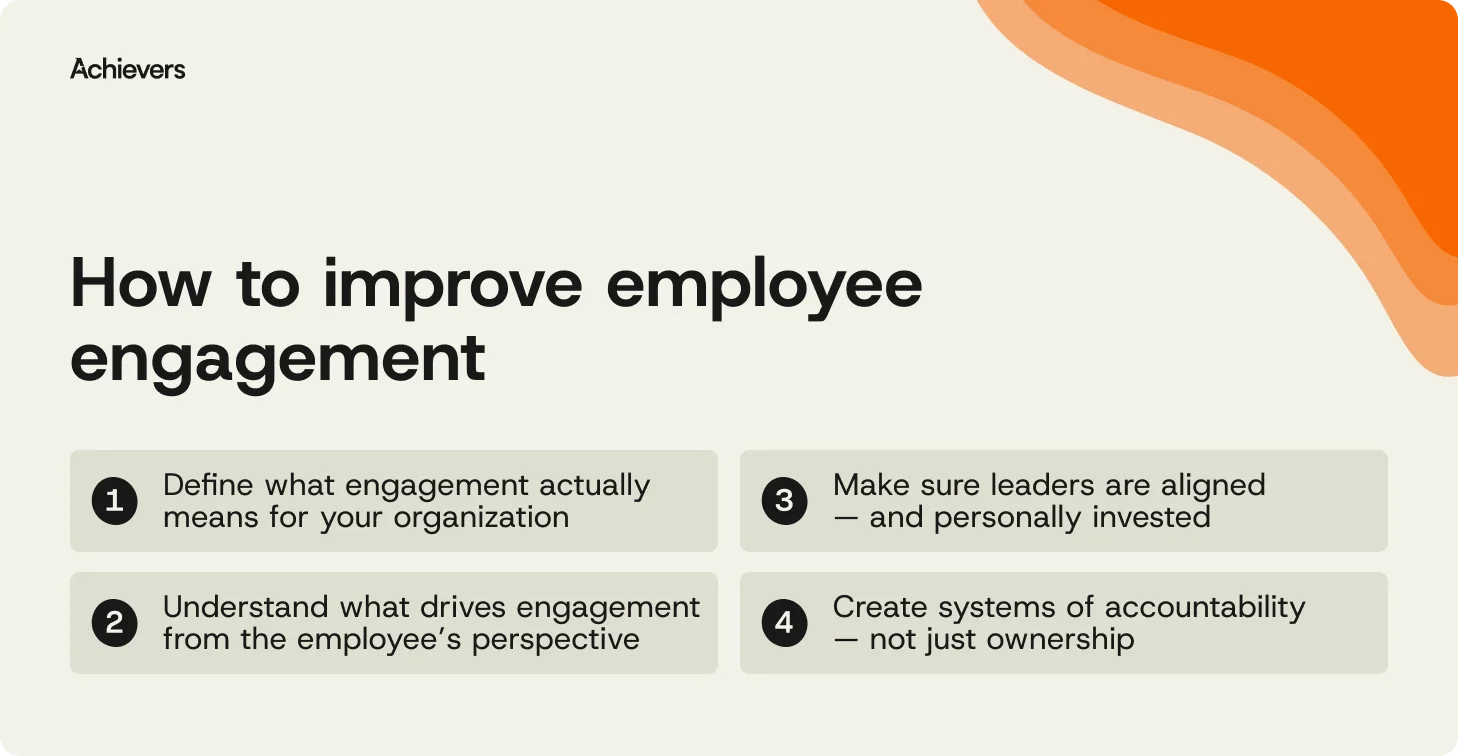Table of contents
Create a culture that means business™
Schedule a demo with an Achievers solution expert today.
Improving employee engagement starts well before a strategy hits the page. It begins with a mindset — one that prioritizes people, listens with intent, and values connection over checkbox culture. It’s about building the right foundation: aligning leadership, measuring what matters, and creating a workplace where recognition isn’t the exception; it’s the norm.
In this blog, we explore eight essential elements — a mix of mindsets, metrics, and momentums — that help organizations create the conditions where engagement can take root and thrive. These are the under-the-surface forces that drive long-term success: the beliefs, behaviors, and systems that shape how people feel at work.
Because when employees feel truly seen, heard, and valued, engagement stops being a program — and starts becoming a way of working — with just enough structure to keep it scalable, and just enough heart to keep it human.
The 8 essentials for improving employee engagement
Improving employee engagement isn’t about quick fixes or one-off programs — it’s about building the right mindset, measuring what matters, and creating momentum that lasts. Whether you’re just getting started or looking to go deeper, these eight essentials will help you create the conditions where engagement can thrive — and stick. Let’s break it down:

1. Define what engagement actually means for your organization
Employee engagement isn’t one-size-fits-anything. Every organization has its own company culture, values, and business goals — and your engagement efforts should reflect that. Start by asking: What does engagement look like here? How does it feel? The clearer your definition, the easier it becomes to build aligned programs and measure what matters. Generic definitions may sound smart on paper, but they rarely move the needle in practice.
2. Understand what drives engagement from the employee’s perspective
Spoiler: It’s not free snacks. Real engagement is rooted in trust, belonging, and a sense of purpose. Employees want to know their work matters and that they matter too. That starts with listening — not assuming — and creating an environment where people feel safe to speak up. When engagement feels personal, not performative, it becomes the fuel for connection, motivation, and culture-wide momentum.
3. Make sure leaders are aligned — and personally invested
Engagement doesn’t trickle down on its own. It needs leaders who are all in — not just in principle, but in practice. When managers are engaged, their teams follow suit. And when they’re not? Well, employees notice. Invest in developing mindful leaders who walk the talk, model your values, and inspire trust. Because the best engagement plans will stall fast without consistent, people-first leadership behind them.
4. Create systems of accountability — not just ownership
Who owns engagement? Everyone. But shared ownership without structure turns into a game of “not it.” To drive lasting impact, build routines and rituals that reinforce engagement at every level — from leadership to frontline teams. When engagement is baked into business rhythms and supported cross-functionally, it becomes sustainable. Think of it less like a side project, and more like a team sport with a scoreboard.
5. Measure what matters (and skip what doesn’t)
Yes, data is essential — but more isn’t always better. To improve engagement, focus on metrics that reflect real progress, not just activity. Go beyond annual pulse surveys and start tracking ongoing feedback, recognition frequency, and behavioral shifts. The goal isn’t to measure everything. It’s to measure the right things — and use that insight to guide smarter decisions (not just prettier dashboards).
6. Build engagement into the employee experience lifecycle
Engagement isn’t something you “launch” — it’s something you live. From the first onboarding email to the last day on the job, every moment in the employee lifecycle is an opportunity to build connection, trust, and meaning. Designing moments that matter (and noticing the ones that don’t) helps close gaps and create consistency. Because people don’t engage in silos — they engage in stories.
7. Culture check: Are your values helping or hurting engagement?
Stated values are easy. Lived values? That’s where the work begins. If there’s a disconnect between what your culture says and what people experience, engagement will suffer — and trust will take the hit. It’s worth the discomfort of an honest culture check. Identifying blockers, owning blind spots, and rebuilding alignment shows employees they’re part of something real. And authenticity is a powerful engagement tool.
8. Keep engagement human, not just efficient
Technology can scale recognition, enable feedback, and provide insight — but it can’t replace human connection. When engagement becomes overly automated, it loses its soul. The goal isn’t speed, it’s sincerity. Use tech to support the human moments: a manager remembering a team win, a colleague sending timely appreciation. The more you keep it personal, the more likely employees are to stay engaged — and stay, full stop.
Engagement that lasts starts with how you think
Improving employee engagement isn’t about flashy perks or quick wins. It’s a long-term commitment rooted in mindset, meaningful measurement, and a culture where people feel seen, heard, and genuinely valued.
That takes focus, consistency, and a willingness to evolve — but it doesn’t have to be overwhelming. When engagement becomes part of how your organization thinks, acts, and grows, it becomes scalable and sustainable.
And with the right support (yes, we mean Achievers), building that kind of culture gets a whole lot easier — and a lot more human. Because people-powered work is the future of work.



